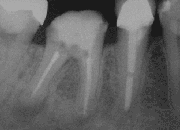Apicoectomy
| Apicoectomy | |
|---|---|
| Intervention | |

X-Ray of a tooth after root end surgery
|
|
| ICD-9-CM | 23.7 |
| MeSH | D001047 |
A root end surgery, also known as apicoectomy ( + ), root resection, retrograde root canal treatment (c.f. orthograde root canal treatment) or root-end filling, is an endodontic surgical procedure whereby a tooth's root tip is removed and a root end cavity is prepared and filled with a biocompatible material.
Microsurgical endodontics - dental surgery using a microscope - may be performed.
This is usually necessitated when a conventional root canal therapy had failed and a re-treatment was already unsuccessful or is not advised. State-of-the-art procedures make use of microsurgical techniques, such as a dental operating microscope, micro instruments, ultrasonic preparation tips and calcium-silicate based filling materials.
Removal of the root tip is indicated to remove the entire apical delta ensuring no uncleaned missed anatomy.
Extraction may be the only alternative. Where necessary prosthetic replacement with a denture, dental bridge or dental implant may be considered.
The primary aim of any endodontic treatment is to disinfect the root canal system in order to reduce the bacterial load as much as possible, and to seal the system to prevent ingress or egress of bacteria or their byproducts. Failure is often due to leakage, and thus any material used to seal the end of the root must provide a good seal. It is also important that they are biocompatible, that is, that they are non-toxic to the surrounding tissues or the body as a whole, and that they are non-carcinogenic. They must also be stable in moisture and at body temperature. It is beneficial if they are easy to handle, as they are placed in small amounts under technically demanding conditions, and if they are easily identified on radiographs (i.e. radio-opaque).
Below is a list of some of the commonly used root-end filling materials. This list is by no means exhaustive.
...
Wikipedia
